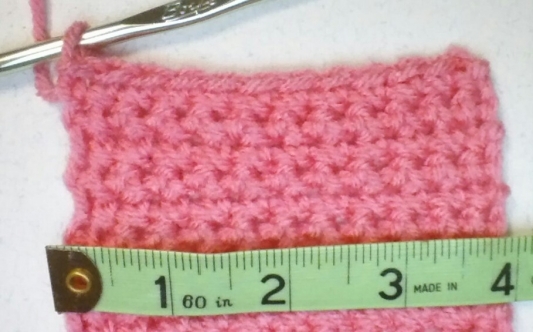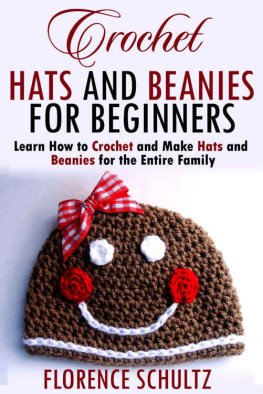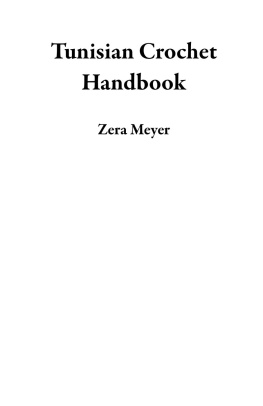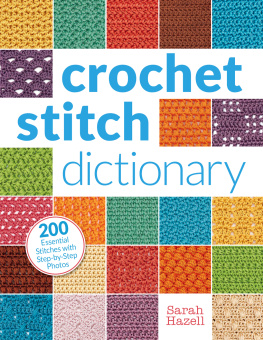Hats are fun projects to crochet because they are quick to work up and make great gifts. In this book you will learn the basics of crochet. First well cover yarn and hooks. Next well move onto putting the hook to yarn and learning basic crochet stitches and techniques. In the next chapter I will help you understand how to adjust a pattern to make it smaller or larger to fit your needs. Then to wrap things up I have included five original patterns to help you practice your new skills. By the time you finish this book you will be well on your way to working all kinds of hat and beanie patterns, as well as other beginner patterns. This book is a tutorial on crochet and making hats and beanies for the absolute beginner. So, are you ready to get started? Lets go!
CHAPTER ONE Hooks and Yarn
Before we begin to learn how to crochet, we need to learn about hooks and yarn. In this chapter well go over the different styles of crochet hooks, the types of fibers used to make yarn, how to read a yarn label, the importance of gauge, and how to choose the correct yarn for your projects.
Crochet Hooks
Crochet hooks come in two main styles; inline and tapered. Both styles create the same stitches, and which one you prefer is up to you. Inline hooks have sharper edges on the hook head while tapered hooks are more curved. Some folks like inline hook because they claim the hook grabs the yarn better than tapered. Other crocheters like tapered hooks because they dont have the tendency to split the yarn like some inline hooks. Personally I like tapered hooks, but I have friends who only use inline, so its up to you which style you prefer.

You can also find hooks with ergonomic grips. These are good if you have arthritis or handling a hook for long periods of time causes pain in your hands or wrist. Most hooks are constructed pretty much the same. The difference may be the length of the handle and the length of the throat between the head and the shaft. Heres a picture of the anatomy of a crochet hook so you can be familiar with the terms used to describe them.

Another type of hook is a Tunisian hook. This type of hook is used for Tunisian crochet and is longer and may have a cable attached to the end to hold stitches. To start out I recommend purchasing a good quality set of aluminum hooks ranging in size from E to K.
Yarn and Yarn Fibers
There are many different types of yarn available today. You can find almost any color or color combination you can think of and in several types of fibers. Todays yarn is soft, easy to care for, and durable. Yarn is made from three main fibers; animal, plant, and synthetic.
Animal Fibers
Animal fibers include wool, alpaca, silk, angora, cashmere, and mohair. Most animal fiber yarns need to be blocked. Once you complete the project dampen the fabric and then roll it up in a big fluffy towel to remove the excess moisture. Next lay it out on blocking mats or another dry towel and smooth it out with your hands. Begin pinning the project working your way around the edges shaping it as you go. Let it dry completely before you remove the pins. Blocking relaxes and opens up the stitches. It also brings out the natural beauty of the crochet. Most animal fibers can be machine washed on gentle, but never put into a dryer.
Plant Fibers
Plant fibers used to make yarn include cotton, linen, soy, hemp, and bamboo. Cotton yarn is good for kitchen and bath projects because it soaks up water very easily. Cotton is also used to create crochet thread used for doilies, tablecloths, and other lacy projects. Bamboo gives you very nice stitch definition and is good for lacy projects like shawls. Linen is suitable for summer and warm weather garments. The fabric wicks away moisture and helps keep you cool. Soy and hemp yarns are very versatile and can be used for many projects. Plant fiber yarns sometimes need blocking depending on the project you have completed. For example a bamboo shawl will transform from a crumpled piece of fabric to a beautiful work of art after blocking. Most plant fiber yarns can be machine washed and dried with no problem, but always check the yarn label.
Synthetic Fibers
Synthetic fibers are derived from petroleum products and include acrylic, polyester, microfiber, and other synthetic fibers. Acrylic yarn is a good choice for many projects. It is easy to work with, easy to care for, and comes in a wide variety of colors and textures. Other synthetic fibers are blended with other types of fibers to add durability, easy of care, and special effects like shine and glitter. Synthetic yarn rarely needs to be blocked and usually be machine washed and dried.
Yarn Weight
Yarn come in weights ranging from lace to jumbo. The following chart outlines the different weights and the recommended hook size for each one.
Yarn Weight Chart |
Weight | Description | Recommended Hook | Stitches in 4 |
| Lace | Fingerling, Size 10 Crochet Thread | Steel 1.6-1.4mm/B-1 | 32-48 |
| Superfine | Sock, Fingerling | 2.25-3mm/B-1 to E-4 | 21-32 |
| Fine | Sport, Baby | 3.4-4.5mm/E-4 to 7 | 16-20 |
| Light | DK, Light Worsted | 4.5-5.5mm/7 to I/9 | 12-17 |
| Medium | Worsted, Afghan, Aran | 5.5-6.5mm/I-9 to K-10 | 11-14 |
| Bulky | Chunky, Craft, Rug | 6.5-9mm/K-10 to M-13 | 8-11 |
| Super Bulky | Super Bulky, Roving | 9-15mm/m-13 to Q | 7-9 |
| Jumbo | Jumbo, Roving | 15mm and up | 6 or more |
Gauge
Gauge refers to the amount of stitches in a 4 inch row of crochet, and the number of rows in a 4 inch swatch of fabric. Always take the time to crochet up a gauge swatch using the yarn and hook size called for in the pattern. This will help you know if you need to go up or down a hook size, or loosen or tighten your tension.


For example, the swatch above was crocheted with Red Heart Super Saver, a weight 4 yarn, and a size I/9 crochet hook. There are 13 stitches in a row, and 15 rows in a four inch square swatch of crochet fabric. Compare these numbers to the gauge in your pattern to be sure your project will turn out the size you expect it to. If your swatch is too large, go down a hook size and crochet up another gauge swatch. If you swatch is too small, go up a hook size and crochet up another gauge swatch.
Yarn Label
One of the most important tools to help you choose the correct yarn for your project is the yarn label. On the yarn label you will find the fiber content, the weight, recommended hook and needle sizes, the gauge, and care instructions. (A complete list of care instruction symbols can be found on the Lion Brand website.)





















